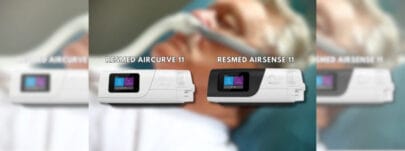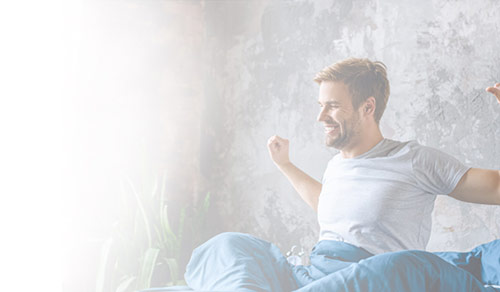
CPAP vs BiPAP vs APAP: Choosing the Right Sleep Therapy Device
Positive airway pressure (PAP) therapy is an effective treatment for sleep apnea, the most common form of which is obstructive sleep apnea. Someone with obstructive sleep apnea can experience frequent breathing pauses while they sleep, caused by blocked airways. PAP therapy helps keep the airways clear.
CPAP, BiPAP and APAP are the three main types of sleep therapy devices used to treat sleep apnea. Each device delivers pressurized air to prevent the collapse of the tissues in the upper airways. However, CPAP, BiPAP and APAP devices differ in the manner in which they manage the delivery of pressurized air.
To compare CPAP vs BiPAP vs APAP and which device may be most suitable, we first need to understand how CPAP works and how it differs from BiPAP and APAP.
What Is CPAP?
CPAP stands for continuous positive airway pressure. It is the most common form of PAP therapy and uses a device to deliver a constant flow of air through a mask worn as you sleep. The mask may cover the mouth, the nose, or even both depending on what best suits your needs and is recommended by your sleep health provider.
The pressure setting is determined by a sleep study and remains the same when you inhale and exhale. While most people will adapt to CPAP and benefit from the treatment, some will find exhaling against the pressurized air difficult and even uncomfortable.
PAP therapy is effective in preventing the collapse of the upper airways. By reducing the symptoms of sleep apnea, including frequently waking for air to counter the breathing pauses, PAP therapy improves the quality of sleep and reduces the risk of health issues linked to sleep apnea, including heart disease, stroke, and diabetes.
However, if you continue to find CPAP difficult to tolerate, placing your compliance with the treatment at risk, you should consult your healthcare provider. They can discuss the merits of CPAP vs BiPAP vs APAP and which device may be more suitable for your needs.
What’s the Difference Between CPAP and BiPAP?
BiPAP provides two-level airway pressure therapy. Your healthcare provider can set two different pressure settings, one for inhalation and one for exhalation. The air pressure is set lower for exhalation, which makes it easier to breathe out.
BiPAP can be a better option for someone who is finding air delivered at a constant pressure for both inhalation and exhalation difficult to tolerate.
BiPAP also offers a higher pressure range than the other two main PAP devices. Therefore, as well as providing a smoother breathing experience, BiPAP could provide a better solution for someone requiring a moderate to higher pressure setting.
What’s the Difference Between CPAP and APAP?
APAP stands for automatic positive airway pressure. When you compare CPAP vs BiPAP vs APAP, it is APAP that is the more advanced and flexible device.
An APAP device monitors your breathing patterns as you sleep, detecting changes and adjusting the pressure of the air delivered. Breathing patterns can deviate throughout the night. This could be a reaction to your sleep position, as sleeping on the back can worsen the symptoms of obstructive sleep apnea as the likelihood of throat tissues being pulled down to obstruct the airways increases.
APAP devices can pick up on these changes in breathing and adjust the air pressure accordingly. Therefore, if the device detects an obstruction to breathing, it will increase air pressure, although within the range set by your healthcare provider. Then, when your breathing eases, the device will lower the pressure once more.
Although this sounds similar to BiPAP, there is a key difference between BiPAP and APAP. Whereas an APAP device makes air pressure adjustments automatically, reacting in real-time to changes in breathing patterns, BiPAP has pressure settings for inhalation and exhalation programmed into the device. Auto BIPAP also exists, which adjusts pressures on a breath-by-breath basis.
CPAP vs BiPAP vs APAP: Choosing the Right Device
At SleepQuest, APAP is generally the first PAP device prescribed to treat sleep apnea. These devices have been extensively researched and are billed under the same code as a standard CPAP device. APAP can also be set to a single fixed pressure like a CPAP device. The main advantage of APAP is that we sleep approximately 20% to 25% in REM sleep. APAP has the advantage of increasing the pressure given during REM sleep when the body is atonic and sleep apnea is at its worst. The other 80% of the night the device remains at a more comfortable lower level during non-REM sleep.
However, every sleep apnea patient is different and treatment is not a simple one-size-fits-all solution. What works for one person does not automatically work for another.
Your healthcare provider or sleep specialist will work with you to compare CPAP vs BiPAP vs APAP to find the device that best suits your needs. BiPAP and APAP may be considered if you struggle to tolerate a constant air pressure setting and need a device with more flexibility.
The following is a guide to which device may be more suitable for you when considering CPAP vs BiPAP vs APAP.
APAP/CPAP may be better for:
- mild to moderate degrees of obstructive sleep apnea
- first PAP device
- budget and insurance as the device tends to be the cheapest
BiPAP may be better for:
- health conditions like chronic obstructive pulmonary disease as exhaling can be easier with BiPAP
- higher pressure setting required to keep the airways clear
- central sleep apnea, a less common form of the sleep disorder where the brain does not send the necessary signals to breathe
APAP may be better for:
- those finding a constant air pressure difficult to tolerate
- uncomplicated moderate to severe obstructive sleep apnea
- breathing patterns that change frequently through the night during REM vs non-REM sleep
- sleeping position changes often
- disorder diagnosed using an at-home test rather than an attended laboratory sleep study
A common consideration when comparing CPAP vs BiPAP vs APAP is price and its potential effect on insurance coverage. BiPAP and APAP devices are more advanced and therefore tend to be more expensive. Modern devices can have additional features to help monitor progress that may also push the price up further.
Finding the right sleep therapy device for you is important for the effective treatment of sleep apnea and for remaining compliant with the treatment plan. CPAP is the most studied form of PAP therapy, while BiPAP and APAP provide more control over pressure settings that can make them easier to tolerate. It is crucial to work with your healthcare provider when considering CPAP vs BiPAP vs APAP.



